     |
||
 Scroll down to explore recordings of other animals from Santa Rosa National Park |
||
| Mantled Howler
Monkey Alouatta palliata Song description Mantled Howler Monkeys howl at dawn and dusk. These haunting and mysterious choruses are composed of low guttural sounds which can carry for more than a kilometer. Most howls begin with short, barking croaks, which crescendo to a full howl before tapering off again. Mantled Howler Monkeys can be triggered to vocalize by the howls of a distant troop of monkeys, by claps of thunder, or by humans who trespass below them. These resonant howls likely serve a communication function between neighbouring groups of monkeys. Habitat and status Mantled Howler Monkeys are fairly common in Santa Rosa, especially in the humid forest. Further reading The monkeys of Santa Rosa National Park are the focus of many excellent research projects. You can read more about Mantled Howler Monkeys in Santa Rosa through the following research papers: Fedigan LM, Rose LM, Avila V. Growth of Mantled Howler Groups in a Regenerating Costa Rican Dry Forest. International Journal of Primatology. 19:385-403. Chapmann C. 1986. Behavioral development of howling monkey twins (Alouatta palliata) in Santa Rosa National Park, Costa Rica. Primates 27:377-381. |
 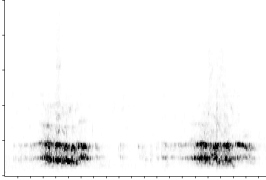 The sound file is 56 seconds (442 kb). The first two howls in the sound file are shown above. 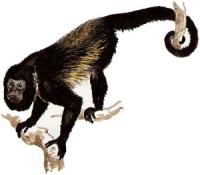 Drawing by Francois Feer From Neotropical Rainforest Mammals |
|
|
|
||
| White-faced
Capuchin
Monkey Cebus capucinus Song description White-faced Capuchin Monkeys produce a variety of long-range and short-range vocalizations. The short-range vocalizations of White-faced Capuchins include sharp barks and squeaks. These can be heard at the beginning and at the end of the sound file presented here. The long-range vocalizations of White-faced Capuchins are loud screams, which are often given in doublets. Habitat and status White-faced Capuchins are highly social animals that travel about in large groups. Each group travels many kilometers each day, moving through both the dry forest and humid forest of Santa Rosa National Park. Although they are cute, monkeys should never be kept as pets: they belong in the forest where they can socialize and travel freely. The growing populations of white-faced capuchin monkeys and other primates in Santa Rosa National Park are a testament to the success of forest conservation and the Park's continued effort to recover the tropical dry forest ecosystem. Further reading Linda Fedigan and her graduate students at the University of Calgary study the behaviour of White-faced Capuchin Monkeys in Santa Rosa National Park. You can read about their research at the following website: http://www.ucalgary.ca/~fedigan/contact.htm Learn more about White-faced Capuchins through the species account in Daniel Janzen's book Costa Rican Natural History (page 458). |
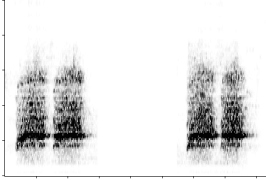 The sound file is 25 seconds (204 kb). The first two screams from the middle of the sound file are shown above. 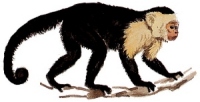 Drawing by Francois Feer From Neotropical Rainforest Mammals |
|
|
|
||
| Spider Monkey Ateles geoffroyi Song description The shyest of the three monkey species found in Santa Rosa, Spider Monkeys produce relatively quiet vocalizations. Their vocal repertoire is complex and includes the horse-like "whinny" presented in the sound recording here. The whinny is often accompanied by piercing high-pitched notes. Habitat and status Spider Monkeys are relatively common in Santa Rosa, but their shy habits make them somewhat difficult to observe. They move very rapidly through the forest upon detecting humans. Further reading Filipo Aureli and his colleagues study the fission/fusion dynamics of spider monkey troops. You can find out more about his research at the following website: http://cwis.livjm.ac.uk/bie/Research/Research_Staff/Bio_Anth/Aureli.htm |
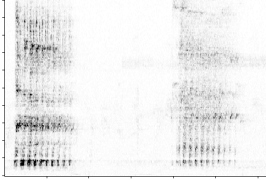 The sound file is 58 seconds (462 kb). The first two whinnys are shown above. 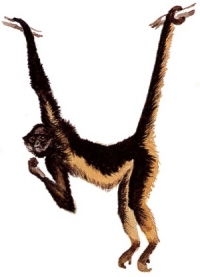 Drawing by Francois Feer From Neotropical Rainforest Mammals |
|
|
|
||
| Variegated Squirrel Sciurus vareigatoides Sound description The Variegated Squirrel wins no prizes for vocal behaviour. However, they are often heard before they are seen and their calls are helpful vocalizations to know. Variegated Squirrel calls are a series of short barking chirps which may be delivered slowly or quickly, usually in alarm at a human. Habitat Variegated Squirrels are found throughout the park, including the dry forest and the humid forest. |
The sound file is 25 seconds (202 kb). The first bout of chatter is shown above. 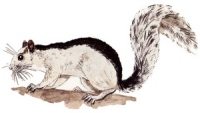 Drawing by Francois Feer From Neotropical Rainforest Mammals |
|
|
|
||
| Central American
Agouti Dasyprocta punctata Sound description Described as "charming dog-sized rodents" in one Costa Rica travel book, Agoutis are quiet and docile animals. Central American Agoutis are generally silent as they forage on the forest floor, but they make loud vocalizations when they are startled. The sounds presented here are the sounds made by Agoutis running away, when they often give short shouts and snorts as they bound through the forest. Habitat and status Agoutis are found in abundance throughout the Santa Rosa. You are likely to see them bounding across the road or scavenging on the forest floor. Further reading You can read more about Central American Agoutis and the important role they play in seed dispersal in tropical forests through the following research papers: Hallwachs W. 1986. Agoutis (Dasyprocta punctata): The inheritors of guapinol (Hymenea courbaril Leguminosae). Pages 285-304 in Estrada A & Fleming TH Frugivores and seed dispersal. Asquith NM, Terborgh J, Arnold AE, Riveros CM. 1999. The fruits the agouti ate: Hymenaea courbaril. Journal of Tropical Ecology 15:229-235. |
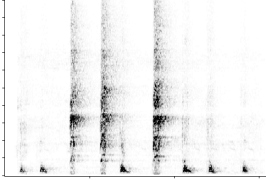 The sound file is 10 seconds (88 kb). The second bout of shouts and snorts from the sound file are shown above. 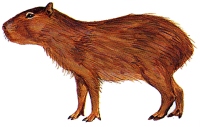 Drawing by Francois Feer From Neotropical Rainforest Mammals |
|
|
|
||
|
All
information on this website is copyright Daniel Mennill 2005 unless
otherwise indicated. No
recordings, photographs, or other information may be used without
written permission from me. Please email me at dmennill AT uwindsor DOT ca
and I will happily grant permission for most non-commercial or
educational
purposes.
|
||

